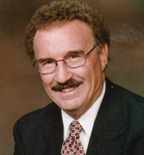Year End Review
LeRoy W. Hooton, Jr.
Salt Lake City Public Utilities Advisory Committee Meeting of December 5, 2003
|
Mr. Hooton told the Public Utilities Advisory Committee that the current drought dominated the Department's activities during the past year. He said that most people do not realize how severe the drought has been. During the past 5 years the mountain snowpack has been lower than normal and precipitation below normal 4 of the 5 years. The drought has adversely affected the state of Utah's recreational opportunities, farming and ranching and wildlife. Weather experts are prognosticating a 50/50 chance that precipitation will improve or continue to be lower than normal this coming year (Brian McInerney, National Weather Service).
The current drought is not the worst drought on record, but it has been severe enough to create adverse impacts on the state. The state's recreation revenues from boating registration, hunting and fishing licenses have declined; agriculture production has been reduced; and wildlife has suffered. There are 620,000 acres of sagebrush, and spruce trees located at elevations between 5,000 and 6000 feet, which are either dead or dying (Utah Department of Natural Resources Executive Director Bob L. Morgan). This has affected the Sage Grouse population and there is concern that this could become a threat to this species.
Mr. Hooton showed a series of slides:
- Utah's reservoir storage has declined to 36 percent of capacity. The most severely impacted are the Bear River and Sevier River drainages.
- Utah's stored water volume has declined by 3.5 million acre-feet between 1999 and 2003.
- Colorado River storage in Lake Powell has decreased from 24 million acre-feet to 12 million acre-feet between 1999 and 2003. Lake Mead is only 46 percent full. The slide of Lake Mead showed the distinct "bath tub ring" denoting the reduced water level in the lake. Last year the ring was about 80 feet wide, it is probably near 90 feet this year.
- Utah Lake is key to next year's water supply in Salt Lake County. It is the hub for the water rights held within the Provo River - Utah Lake - Jordan River Drainage. Historic water levels have fluctuated during wet and dry cycles. In the early 1920s the lake level was above compromise level; however, beginning in the late 1920s it began to decline due to the effects of a dry cycle. The lake level reached its lowest level in 1934 and was below compromise for nearly 25 years. Between about 1965 and 1988 the lake was above compromise. In 1992 the lake level dropped to 8 feet below compromise and water no longer could be pumped from the lake. It appears that if the dry cycle continues this may occur again in 2004. In 1992 it was necessary to deliver up to 38 cubic feet per second of drinking water to irrigation ditches to meet the City's exchange agreement obligations. Late this year this was again necessary when the Utah Lake Pumping Plant was turned off on October 1, due to the low water level in the lake.
- The drought of the 1930s is the most severe recorded. Mr. Hooton referred to a slide showing Governor Blood and Salt Lake City Mayor Lewis Marcus driving over the dry bed of Utah Lake in 1934.
- Under a 1934 drought emergency program the Pelican Point Pumping Plant was constructed on the west side of Utah Lake. The pumping plant and 12,000 feet of conveyance canal provided some relief to Salt Lake City and the County's farmers.
- The Lehi Utah Lake Pumping Plant located at the outlet of Utah Lake provides irrigation water to various canals within Salt Lake County. In 1907 it was the largest pumping plant in the United States with 700 cubic feet per second of pumping capacity.
- The Lehi Utah Lake Pumping Plant was re-built in 1912 and today, still lifts water from the lake to deliver water to various canals within Salt Lake County.
- The drought of the 1930s led to the formation of the Metropolitan District of Salt Lake City and the Provo River Project.
- Mr. Hooton pointed out that without water conservation and spot market water purchases, the City would have not successfully made it through this drought period. Between 2001 and 2004, 16,687 acre-feet of spot market water was purchased and 25,000 acre-feet of water conserved. If this combination of water supply enhancement and conservation had not been made, there would be no reserves left in Deer Creek Reservoir to protect against another year of drought. Currently, the Metropolitan Water District has nearly 25,000 acre-feet of holdover water supply in Deer Creek Reservoir for next year. The City's water customers are to be commended for their outstanding water conservation effort.
- The volume of water conserved would cover 25,000 acres one-foot deep, covering an area bound by approximately 1300 East to 3200 West and the Davis County line to 2100 South.
Mr. Hooton briefly outlined some of the challenges facing the Department this coming year. He advised that at the beginning of the new year, the Committee will be faced with updating the State required Water Conservation Plan, dealing with the 10-year Financial Plan and the FY 2004-05 Budget. Furthermore there will be issues related to the upcoming legislative session. Governor Walker is talking about eliminating sales tax revenues for state water projects. Last year Governor Leavitt made the same proposal and espoused having a surcharge on retail water rates to finance state water projects. Mr. Hooton voiced his strong opposition to having Salt Lake City water customers paying for statewide water projects by placing a tax or surcharge on their water bills.
Mr. Hooton expressed his appreciation to retiring committee member Dr. Harry Gibbons.
Mr. Hooton thanked the Public Utilities Advisory Committee, the Mayor and administration and the City Council for their support. He wished everyone a Merry Christmas and a Happy New Year.
